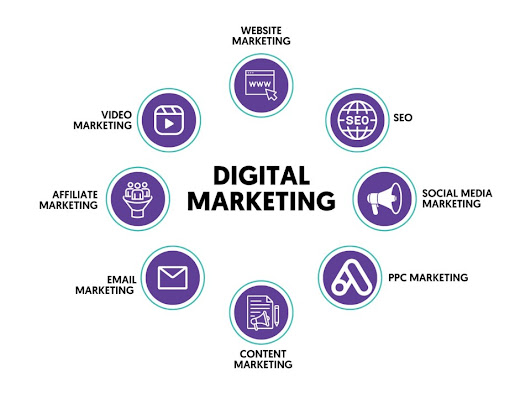The Essential Components of a Winning Digital Marketing Strategy
Introduction:
Crafting a successful digital
marketing strategy requires a comprehensive approach that encompasses various
components to achieve desired outcomes. From building brand awareness and
generating leads to driving conversions and fostering customer loyalty, a
well-rounded digital marketing strategy leverages a combination of tactics and
channels tailored to the unique needs and objectives of the business. In this
discussion, we will explore the key components of a successful digital
marketing strategy and how they work together to deliver tangible results.
Clear Objectives and Goals:
At the heart of any successful
digital marketing strategy lies a set of clear and measurable objectives and
goals. These objectives serve as the guiding principles that steer the
direction of the strategy and provide a framework for evaluating success.
Whether it's increasing website traffic, generating leads, improving brand
awareness, or boosting sales, defining specific, achievable goals ensures alignment
across all marketing efforts and enables effective performance tracking and
optimization.
Target Audience Segmentation:
Understanding the target audience
is essential for crafting a digital marketing strategy that resonates with
potential customers. Through audience segmentation, businesses can divide their
target market into distinct groups based on demographics, interests, behaviors,
and other relevant criteria. By tailoring marketing messages and campaigns to
address the unique needs and preferences of each segment, businesses can
enhance relevance, engagement, and conversion rates.
Compelling Content Creation:
Content lies at the heart of
digital marketing and plays a pivotal role in attracting, engaging, and
converting audiences. From blog posts and articles to videos, infographics, and
social media posts, businesses must create high-quality, relevant, and valuable
content that educates, entertains, or inspires their target audience. By
providing valuable information, solving problems, or addressing pain points,
businesses can establish themselves as trusted authorities in their industry
and build stronger relationships with their audience.
Search Engine Optimization (SEO):
Search engine optimization (SEO)
is essential for improving the visibility and ranking of a website in search
engine results pages (SERPs). By optimizing website structure, content, and
metadata for relevant keywords and phrases, businesses can increase organic
traffic and attract qualified leads to their website. Effective SEO tactics
include keyword research, on-page optimization, link building, and technical
optimization to ensure that the website is easily accessible and indexable by
search engines.
Social Media Marketing:
Social media has become a
powerful channel for businesses to engage with their audience, build brand
awareness, and drive traffic to their website. A successful social media
marketing strategy involves identifying the most relevant platforms for
reaching the target audience, creating compelling content that resonates with
users, and fostering meaningful interactions and conversations. By leveraging
social media advertising, influencer partnerships, and community management,
businesses can amplify their reach and impact on social media.
Email Marketing:
Email marketing remains one of
the most effective channels for nurturing leads, driving conversions, and
fostering customer loyalty. A successful email marketing strategy involves
building and segmenting an email list, creating personalized and relevant
content, and implementing automated workflows to deliver timely and targeted
messages to subscribers. By providing value through informative newsletters,
promotional offers, and exclusive content, businesses can strengthen
relationships with their audience and drive repeat business.
Pay-Per-Click Advertising (PPC):
Pay-per-click (PPC) advertising
allows businesses to reach their target audience through targeted ads displayed
on search engines and other digital platforms. A successful PPC strategy
involves conducting keyword research, creating compelling ad copy and visuals,
and optimizing campaigns for maximum performance and ROI. By targeting specific
keywords, demographics, and interests, businesses can drive qualified traffic
to their website and generate leads or sales through paid ads.
Conversion Rate Optimization (CRO):
Conversion rate optimization
(CRO) focuses on improving the effectiveness of digital marketing efforts by
maximizing the percentage of website visitors who take desired actions, such as
making a purchase, filling out a form, or signing up for a newsletter. A
successful CRO strategy involves analyzing user behavior, identifying barriers
to conversion, and implementing changes to the website layout, design, and
messaging to remove friction and encourage conversions.
Analytics and Performance Tracking:
Analytics and performance
tracking are essential for measuring the effectiveness of a digital marketing
strategy and identifying areas for improvement. By leveraging web analytics
tools such as Google Analytics, businesses can track key performance indicators
(KPIs) such as website traffic, engagement metrics, conversion rates, and ROI.
This data-driven approach enables businesses to make informed decisions,
optimize marketing campaigns in real-time, and allocate resources more
effectively to achieve their goals.
Continuous Optimization and Iteration:
A successful digital marketing
strategy is not static but rather dynamic and iterative, requiring continuous
optimization and refinement based on ongoing performance analysis and feedback.
By monitoring key metrics, conducting A/B tests, and experimenting with new
tactics and channels, businesses can identify what works and what doesn't and
adapt their strategy accordingly. This iterative approach enables businesses to
stay agile, responsive, and competitive in the ever-evolving digital landscape.
Conclusion:
A successful digital marketing strategy encompasses a range of interconnected components that work together to achieve business objectives and drive results. By setting clear goals, understanding the target audience, creating compelling content, and leveraging various channels and tactics, businesses can effectively reach, engage, and convert their target audience in the digital realm. Moreover, by embracing data-driven decision-making, continuous optimization, and iteration, businesses can adapt to changing market conditions and stay ahead of the curve in today's competitive landscape.






0 Comments